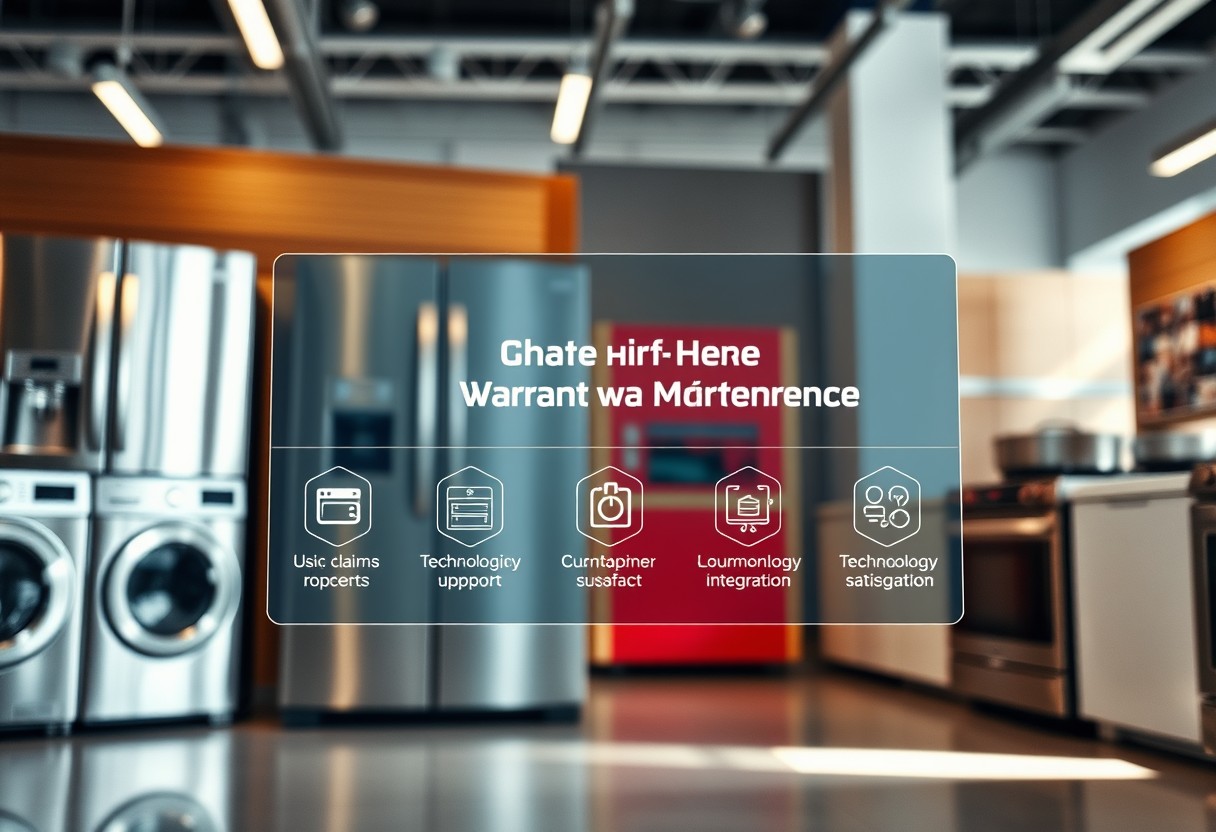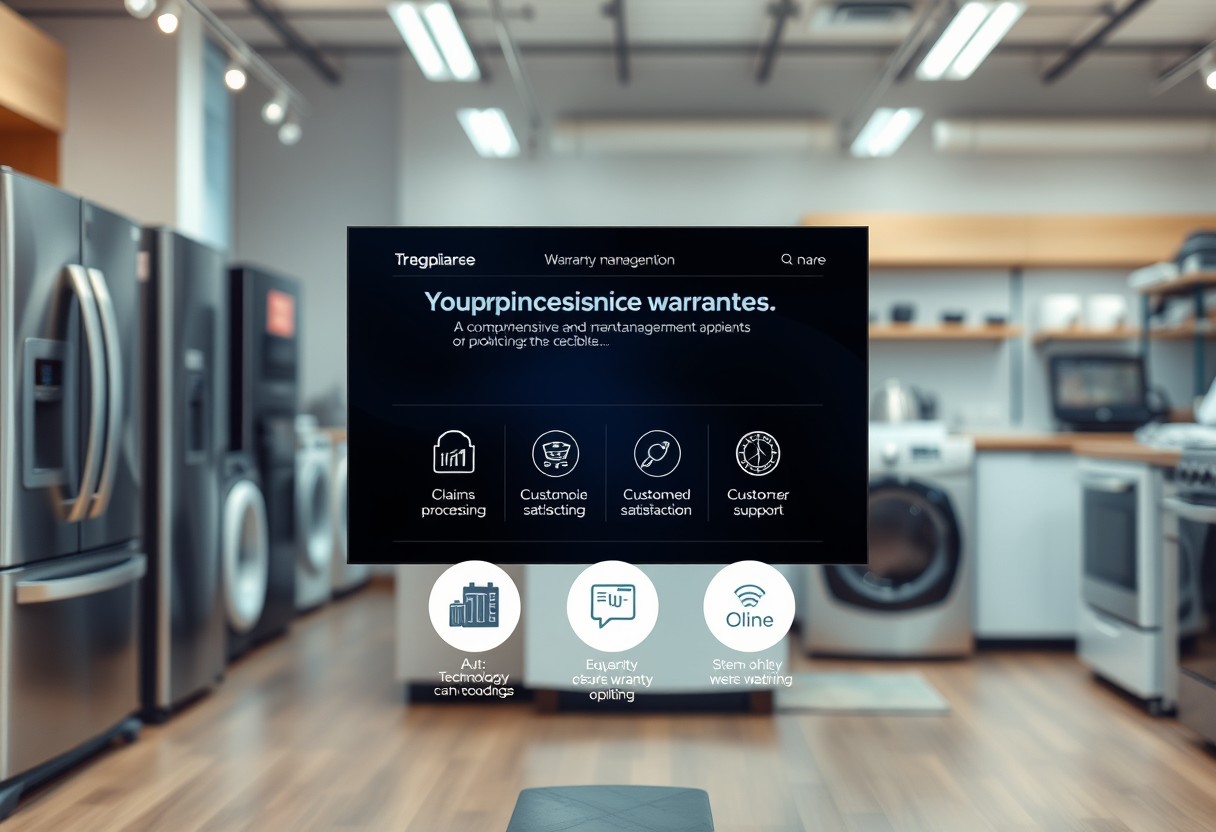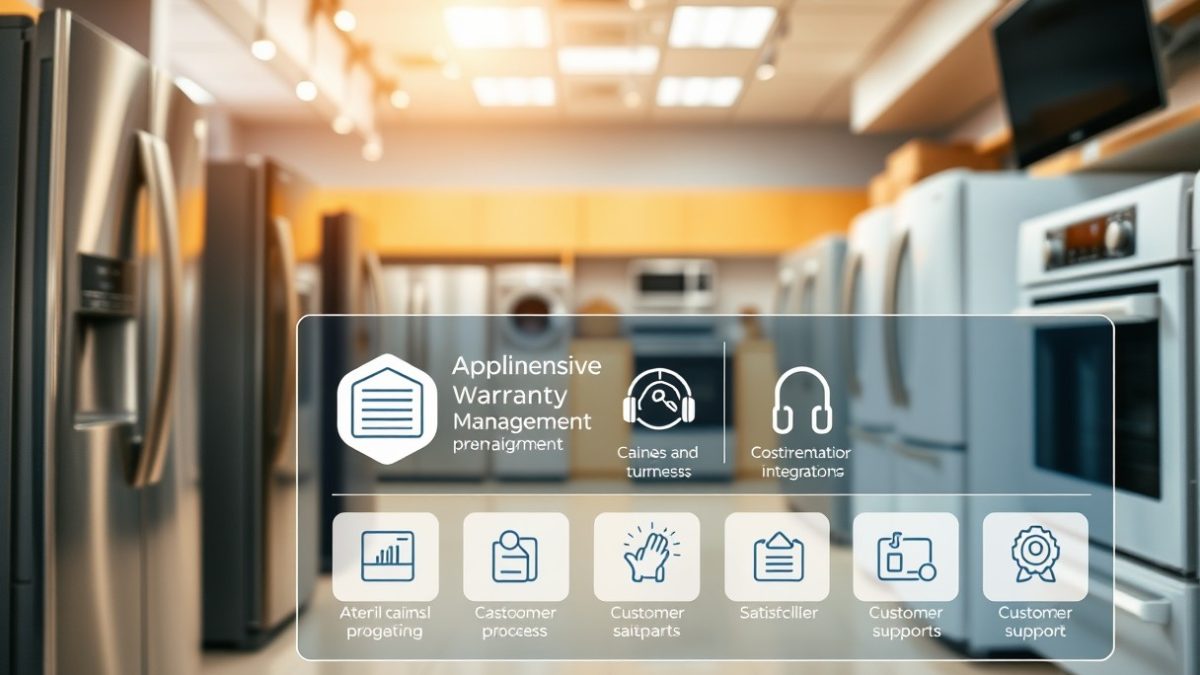
Gas appliance installations
August 22, 2024
What Innovative Strategies Improve Customer Engagement In Extended Warranty Programs?
August 27, 2024Over the years, the landscape of appliance retailing has evolved dramatically, and a fully integrated warranty system is now a vital tool that can revolutionize your operations. With such a system, you can streamline claims processing, minimize gaps in coverage, and enhance customer satisfaction—all while reducing operational costs. By managing warranties seamlessly within your existing systems, you not only improve efficiency but also strengthen your customer relationships and boost sales. In this post, discover why adopting an integrated warranty solution can transform your business for the better.
Key Takeaways:
- Enhanced Customer Experience: A fully integrated warranty system streamlines the process for customers, ensuring seamless claims and support, which can significantly boost customer satisfaction and loyalty.
- Increased Operational Efficiency: By automating warranty processes, retailers can reduce administrative burdens and costs, allowing them to focus more on sales and customer service.
- Data-Driven Insights: An integrated system provides valuable data analytics that can help retailers understand product performance and customer needs, leading to improved inventory management and targeted marketing strategies.
Understanding Warranty Systems
For appliance retailers, grasping the core concepts of warranty systems is crucial for maximizing customer satisfaction and streamlining operations. A warranty system not only provides customers with security and peace of mind but also serves as a vital component of your sales strategy. By incorporating a comprehensive warranty approach, you can better manage customer expectations while protecting your business interests.
Definition of Warranty Systems
Systems of warranty refer to the policies, processes, and agreements that outline how a product is covered after purchase. This typically includes the conditions under which repairs, replacements, or refunds are granted, depending on the nature of the appliance’s malfunction or damage. A well-defined warranty system is important for ensuring that all parties involved understand their rights and responsibilities when issues arise.
Types of Warranty Coverage
There are several types of warranty coverage that you may come across as an appliance retailer. Understanding these categories can help you tailor your offerings based on customer needs, thereby enhancing trust and loyalty. The following table summarizes the main types of warranty coverage:
| Type of Warranty | Description |
| Limited Warranty | Covers specific parts or issues during a designated period. |
| Extended Warranty | Provides additional coverage beyond the manufacturer’s warranty. |
| Full Warranty | Covers the entire product for a specific time with no charges. |
| Service Contracts | Offers ongoing maintenance and repair services for a fee. |
| Implied Warranty | Automatically provides certain rights to the consumer under law. |
Warranty coverage plays a pivotal role in shaping customer perceptions and can significantly impact your bottom line. Each type of warranty comes with its own set of advantages, such as increased customer retention and reduced claims processing time. Understanding these categories empowers you to offer products that align with your customers’ preferences.
- Limited Warranty: Specific parts or issues covered.
- Extended Warranty: Additional coverage beyond standard.
- Full Warranty: Covers everything for a defined period.
- Service Contracts: Ongoing maintenance paid by the customer.
- Implied Warranty: Legal rights automatically granted.
Recognizing the different forms of warranty coverage allows you to equip your sales team and customers with the necessary knowledge to make informed decisions.
Importance of a Warranty System for Retailers
Retailers must understand the importance of a well-structured warranty system to sustain competitive advantages in the appliance market. A robust warranty process can improve your credibility and customer satisfaction, positioning you as a reliable source for appliance needs. The assurance of a solid warranty also motivates customers to make a purchase, as they feel confident in their investment.
Plus, having a comprehensive warranty system benefits your operational efficiency. It streamlines the claims process, minimizes legal disputes, and strengthens relationships with warranty providers. This structure enables you to allocate resources effectively while also fostering customer loyalty through exceptional service and support. In essence, a well-defined warranty system can significantly enhance your reputation, making it a key strategy for your retail success.
The Need for Integration
While many appliance retailers operate using traditional warranty management systems, they often face inherent challenges that hinder efficiency and customer satisfaction. These systems are typically isolated and fragmented, creating obstacles in the warranty claims process. This lack of connectivity can lead to an increase in processing errors and delays that frustrate customers and employees alike. [[1]] A disjointed approach to warranty management can even result in a poor customer experience, as your customers will struggle to obtain information about their warranties and make claims when necessary. In today’s fast-paced retail environment, these inefficiencies can severely hamper your business’ reputation and bottom line.
Challenges with Traditional Warranty Management
Needless to say, managing warranties manually or through inaccessible digital systems can overwhelm your team. Miscommunication and a lack of real-time data transfer can further complicate the claims process, resulting in lost claims or misrepresentations that ultimately erode consumer trust. If customers don’t feel confident in your warranty process, they may take their business elsewhere, which is something you cannot afford in a competitive market.
Benefits of an Integrated Approach
To overcome the complications of traditional methods, an integrated warranty system presents a powerful solution. By combining various functions of warranty management—such as claim processing, customer interaction, and repair tracking—into one cohesive platform, you can streamline operations and enhance communication. This level of integration allows for real-time updates and transparent access to information, making it easier for both your team and your customers to navigate the warranty landscape.
A fully integrated warranty system simplifies workflows, reduces administrative burdens, and minimizes human error. You can expect a noticeable increase in efficiency as your staff spends less time on warranty claims and more on providing excellent customer service. Moreover, customers experience a smoother process from the moment they purchase an appliance, gaining instant access to their warranty details and the ability to file claims easily, thus elevating their overall satisfaction.
Key Components of an Integrated Warranty System
Needless to say, the most effective integrated warranty systems include several key components: automated claim processing, centralized data management, real-time tracking capabilities, and seamless customer communication channels. Each of these elements works in unison to eliminate inefficiencies and provide your team with comprehensive insights into warranty performance. Automated claim processing alone can save valuable time, reducing the lag time and stress often associated with warranty claims.
Challenges arise when these components are not present or fail to communicate with each other effectively. When your warranty system lacks these important elements, not only do your employees have to work harder, but you also risk leaving customers dissatisfied. Enabling state-of-the-art features like artificial intelligence for data analysis and automated alerts ensures that nothing falls through the cracks, improving your warranty management overall.

Enhancing Customer Experience
Keep in mind that today’s consumers are searching for a seamless experience when purchasing appliances and managing their warranties. A fully integrated warranty system can significantly enhance your customer experience by reducing friction in the warranty process and delivering on customer expectations. By automating various elements such as registration, claims, and communication, you not only save time for your customers but also boost their confidence in your brand.
Streamlining the Claim Process
To facilitate a more efficient claims process, it’s critical to adopt a system that allows customers to submit their claims easily online or through mobile interfaces. Gone are the days of long phone calls and tedious paperwork; a digital claims submission means your customers can report issues at their convenience, leading to quicker resolutions. With fewer hurdles to navigate, your customers will feel more empowered, knowing that you prioritize their time and experience.
To further streamline the process, consider integrating real-time tracking of claims status. By offering your customers updates along the way, you keep them informed and engaged throughout the resolution process. This immediate access to information not only enhances the overall service experience but also reduces the number of inquiries you receive regarding claim statuses, freeing up your resources for other important tasks.
Improving Transparency and Communication
One of the detrimental aspects of traditional warranty experiences is the lack of transparency. Customers often feel left in the dark about their claims, which can lead to frustration and mistrust. Leveraging a fully integrated warranty system allows you to provide clear, consistent communication to your customers, ensuring they are always aware of what to expect. Regular updates about their claims status, next steps, and additional resources make them feel valued and engaged.
One of the standout benefits of improving transparency is the ability for you to establish a trustworthy relationship with your customers. When they receive timely notifications and transparent communication throughout the warranty process, they are far more likely to have a positive perception of your brand. Your customers appreciate knowing that you are there for them, which then translates to increased satisfaction and loyalty.
A transparent approach to warranty management not only increases customer satisfaction but also reduces the likelihood of disputes. When expectations are well-communicated and align with your service delivery, customers feel reassured and valued. This can lead to enhanced customer reviews and word-of-mouth referrals, significantly amplifying your brand’s visibility and reputation.
Building Customer Trust and Loyalty
Loyalty in the modern retail landscape is built on trust. A fully integrated warranty system can serve as a linchpin for encapsulating that trust. By enabling customers to easily file claims, access information, and receive timely responses, you create a consistently positive experience. Trust is integral to ensuring that your customers keep coming back, and the warranty experience can be a critical factor in their decision-making process.
Loyal customers often translate to increased lifetime value for your business. When you streamline the warranty process and keep communication open, you set the stage for customers to not only trust you with their appliance purchases but also foster a long-term relationship with your brand. The more positive interactions they have, the more likely they are to share their experiences with others.
Experience has shown that customers who feel secure and assured in their warranty and repair processes are more inclined to make repeat purchases. They go from being merely customers to brand advocates, which is a vital aspect of sustaining your business in a competitive marketplace. By investing in a fully integrated warranty system, you position your business as a leader in customer service, paving the way for ongoing success.

Operational Efficiency
After implementing a fully integrated warranty system, you will notice a significant shift in the operational efficiency of your appliance retail business. This transformation centers around the streamlining of various processes, thereby allowing your team to focus on more productive tasks rather than being bogged down by administrative burdens.
Reducing Administrative Workloads
Any time-consuming administrative tasks—such as managing warranty claims, processing returns, or tracking customer information—can drastically impact your overall efficiency. A fully integrated warranty system automates these processes, which reduces the need for manual entry and decreases the chances of human error. Consequently, your employees will be able to redirect their energies towards enhancing customer service and driving sales, ultimately benefiting your bottom line.
Real-Time Data Access and Analysis
Efficiency in decision-making is crucial for your business. With a fully integrated warranty system, you gain access to real-time data that provides invaluable insights into customer behavior and product performance. This allows you to make informed decisions swiftly, adapting your strategies based on immediate feedback without unnecessary delays.
Understanding how your products perform in the market can give you a competitive edge. Real-time data enables you to analyze trends, identify recurring issues, and track warranty claims closely. With this knowledge at your fingertips, you can ensure timely responses to customer needs and concerns, enhancing customer trust and loyalty in the process.
Automating Warranty Processes
One of the standout features of a fully integrated warranty system is the automation of warranty processes. This means that everything from registration to claim processing can be handled automatically, thereby significantly reducing the time and resources you would typically allocate to these tasks. As a result, your operational efficiency will skyrocket, allowing you to offer quicker resolutions to your customers.
Analysis of your newly automated processes will show you the vast improvements in turnaround times and customer satisfaction levels. Not only does automation eliminate the risk of inconsistencies in your warranty handling, but it also streamlines the flow of information within your company, allowing for smoother interactions across all departments.
Financial Implications
Unlike traditional warranty systems that often lead to fragmented processes and hidden costs, a fully integrated warranty system offers a transparent and efficient way to manage warranty services. By streamlining the warranty process, you can significantly reduce operating costs and enhance profitability. This transformation allows you to track expenses associated with warranty claims more accurately, enabling you to make informed financial decisions. Investing in such a system can seem daunting initially, but the return on investment (ROI) can be substantial when you consider the enhanced customer satisfaction and reduced administrative burdens.
Cost-Benefit Analysis of Integrated Warranty Systems
Warranty systems that are integrated into your overall operations enable you to identify cost-saving opportunities that may go unnoticed in a fragmented setup. For instance, having an integrated platform allows you to analyze claim data effectively, identifying trends that point to potential defective products. By addressing these issues proactively, you can reduce return rates and associated costs, leading to improved margins overall.
Additionally, an integrated warranty system aids in optimizing your supply chain by facilitating better communication between your sales, service, and warranty teams. As a result, not only do you get to streamline your operations, but overall operational efficiency improves, thus enhancing your bottom line. By weighing these benefits against the cost of implementation, you may find that the long-term financial advantage significantly outweighs the initial investment.
Impact on Sales and Revenue
Sales are directly influenced by the warranty options you offer. When customers perceive that a retailer provides a robust and reliable warranty system, their confidence in purchasing a product escalates. This perception creates an avenue for increased customer loyalty and the potential for upsell opportunities. Not only does a well-designed warranty system reassure customers, but it can also differentiate you from competitors who may not provide similar support.
The implementation of a fully integrated warranty system can greatly enhance your sales numbers. The more streamlined and transparent the warranty process, the more likely customers are to convert from prospects to buyers. Furthermore, satisfied customers often share their positive experiences, driving organic growth through word-of-mouth referrals and improving your brand image.
Managing Warranty Liabilities and Reserves
Impact on your warranty liabilities is another area where integrated systems shine. With a comprehensive overview of warranty claims and expenses, you can forecast potential liabilities more accurately. Also, understanding trends and patterns will allow you to set aside the appropriate reserves, ensuring that you meet future obligations without financial strain.
Effective management of your warranty liabilities can also lead to enhanced cash flow. When you can anticipate and allocate resources strategically, you mitigate the risks associated with unexpected claims, allowing you to reinvest in your business wisely. This proactive approach ensures your financial stability in the long run, enabling sustained growth and operational efficiency.
Revenue growth is directly impacted by how you manage not just the warranty claims, but also the customer relationships surrounding them. A positive and efficient warranty experience can turn hesitant buyers into loyal customers, ensuring repeat business and increased lifetime value. With a system that keeps track of warranty usage, you’ll also have valuable insights for optimizing your products, thus driving further sales opportunities.
Technology and Innovation
Role of Technology in Warranty Integration
Your experience in the appliance retail industry is about to undergo a significant transformation, thanks to the advancing power of technology. Integrating a fully managed warranty system means that all warranty claims, processes, and records are consolidated into a single, easily accessible platform. An effective integration relies on comprehensive software solutions that ensure real-time information sharing between retailers, manufacturers, and service providers. This seamless flow of data allows you to make informed decisions promptly, ultimately enhancing the customer experience and boosting your operational efficiency.
Furthermore, automated processes and AI-driven analytics contribute to minimizing human error and reducing the workload for your staff. With automated notifications regarding warranty statuses and expiration dates, you never have to worry about missed deadlines again. Your team can focus on what truly matters—providing exceptional service to your customers—while technology handles the repetitive tasks involved in warranty management.
Future Trends in Warranty Management
Management of warranties will continue to evolve as technology advances. The integration of IoT (Internet of Things) devices into appliances is expected to revolutionize how warranties are monitored and managed. Instead of waiting for consumers to report issues, smart appliances could automatically alert manufacturers or retailers whenever a fault occurs. This proactive approach not only improves customer satisfaction but also provides invaluable data for ongoing product development.
Moreover, blockchain technology is emerging as a game changer in warranty management. By creating immutable records of transactions, blockchain can simplify the claims process and add a layer of security that traditional systems cannot provide. Retailers who adapt to these evolving technologies can expect to enhance their service delivery and strengthen consumer trust in their warranties.
Warranty solutions aimed at automating and simplifying warranty claims will soon become the norm for appliance retailers. As more businesses implement these cutting-edge technologies, anticipating consumer needs will not only drive customer loyalty but will also help reduce the overall costs associated with warranty claims and service work.
Choosing the Right Software Solutions
Solutions for warranty management should encompass comprehensive features that meet your unique operational needs. When evaluating software options, consider scalability, integration capabilities, and user-friendliness. The ideal software should not only fit your current size but also adapt to your growing business demands. Make sure to choose a solution that allows for seamless integration with your existing systems and processes, reducing the disruption of switching to a new platform.
Additionally, prioritize solutions that offer strong customer support and training resources. You want a software partner that will assist you during the onboarding process and beyond, ensuring that your team can utilize the system effectively. Making the right choice now can significantly impact your warranty management efficiency and customer satisfaction down the line.
Future advancements will introduce even more sophisticated solutions, further streamlining warranty processes. As technology evolves, so too should your strategies for warranty management. By remaining adaptable and open to new software innovations, you position your business to reap the rewards of an integrated warranty system.
Conclusion
With this in mind, it becomes evident that a fully integrated warranty system is not just a modernization of processes for appliance retailers; it is a transformative strategy that can significantly enhance your business operations. You gain the ability to streamline claims, reduce administrative costs, and improve customer satisfaction by centralizing warranty management. This not only helps in fostering loyalty among your customers but also positions your brand as a trustworthy and reliable choice in a competitive marketplace. Ultimately, a seamless warranty experience can be the deciding factor in winning repeat business and referrals.
Moreover, adopting a comprehensive warranty system equips you with valuable data insights that can drive strategic decisions within your retail operations. You can analyze warranty claims trends, foresee potential appliance malfunctions, and tailor your inventory to better meet customer needs. By leveraging this information, you ensure your offerings remain relevant and your customer service is proactive rather than reactive. Conclusively, embracing a fully integrated warranty system can be a game-changer for you as an appliance retailer, leading to improved operational efficiency and a more loyal customer base.
FAQ
Q: What is a fully integrated warranty system and how does it work for appliance retailers?
A: A fully integrated warranty system is a comprehensive software solution that combines warranty management with point of sale (POS) systems and customer relationship management (CRM) tools. This system allows appliance retailers to manage warranties, claims, and service requests seamlessly from a single platform. By leveraging real-time data, retailers can track warranty status, access customer history, and automate claims processing, leading to enhanced efficiency and reduced administrative burdens.
Q: How does a fully integrated warranty system improve customer satisfaction for appliance retailers?
A: By utilizing a fully integrated warranty system, appliance retailers can significantly enhance the customer experience. Customers benefit from streamlined warranty claims processes, immediate access to information regarding their product warranties, and more efficient service scheduling. With such a system, retailers can resolve issues more quickly, provide timely updates, and proactively communicate with customers. This level of attentiveness fosters trust and loyalty, ultimately elevating customer satisfaction.
Q: What are the financial benefits of adopting a fully integrated warranty system for appliance retailers?
A: Implementing a fully integrated warranty system can lead to substantial financial advantages for appliance retailers. Firstly, it reduces operational costs by automating claim processes and minimizing manual paperwork. Secondly, it helps prevent revenue loss through improved tracking of warranty claims and customer data analytics, allowing retailers to identify trends and address potential customer issues before they escalate. Lastly, a better warranty experience can drive repeat business and referrals, contributing positively to overall profitability.

